Jump to:
What is Miso Soup?
Japanese miso soup features yellow miso paste, soft tofu, and seaweed simmered in a dashi stock in Japanese cuisine. Many Japanese restaurants will typically serve this traditional soup before your main meal.
The first time I had a bowl of miso soup I remember the delicious savory broth with that salty flavor. It's one of my favorite Asian soups in Japanese cooking because it's such a simple dish that uses minimal ingredients to make!
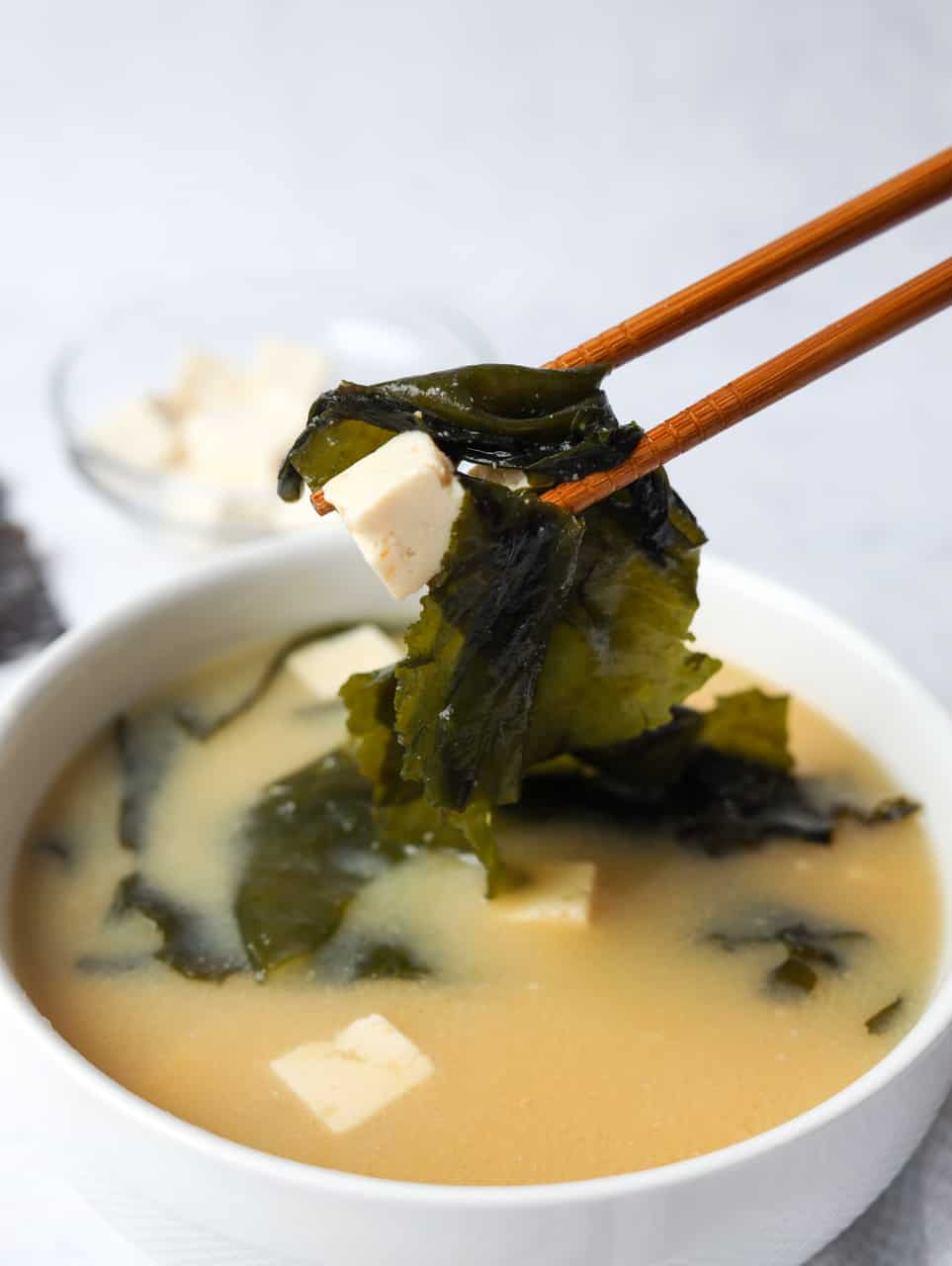
I love eating miso soup before my meal or you can also simply serve this as a main dish with white rice because it contains protein and fiber.
Homemade miso soup is one the easiest Japanese dishes to make with simple ingredients and little time! I often make this during the colder months when I'm craving soup but you can also enjoy it all year round!
Ingredients & Substitutes
Please scroll down to the below Recipe card for full measurements
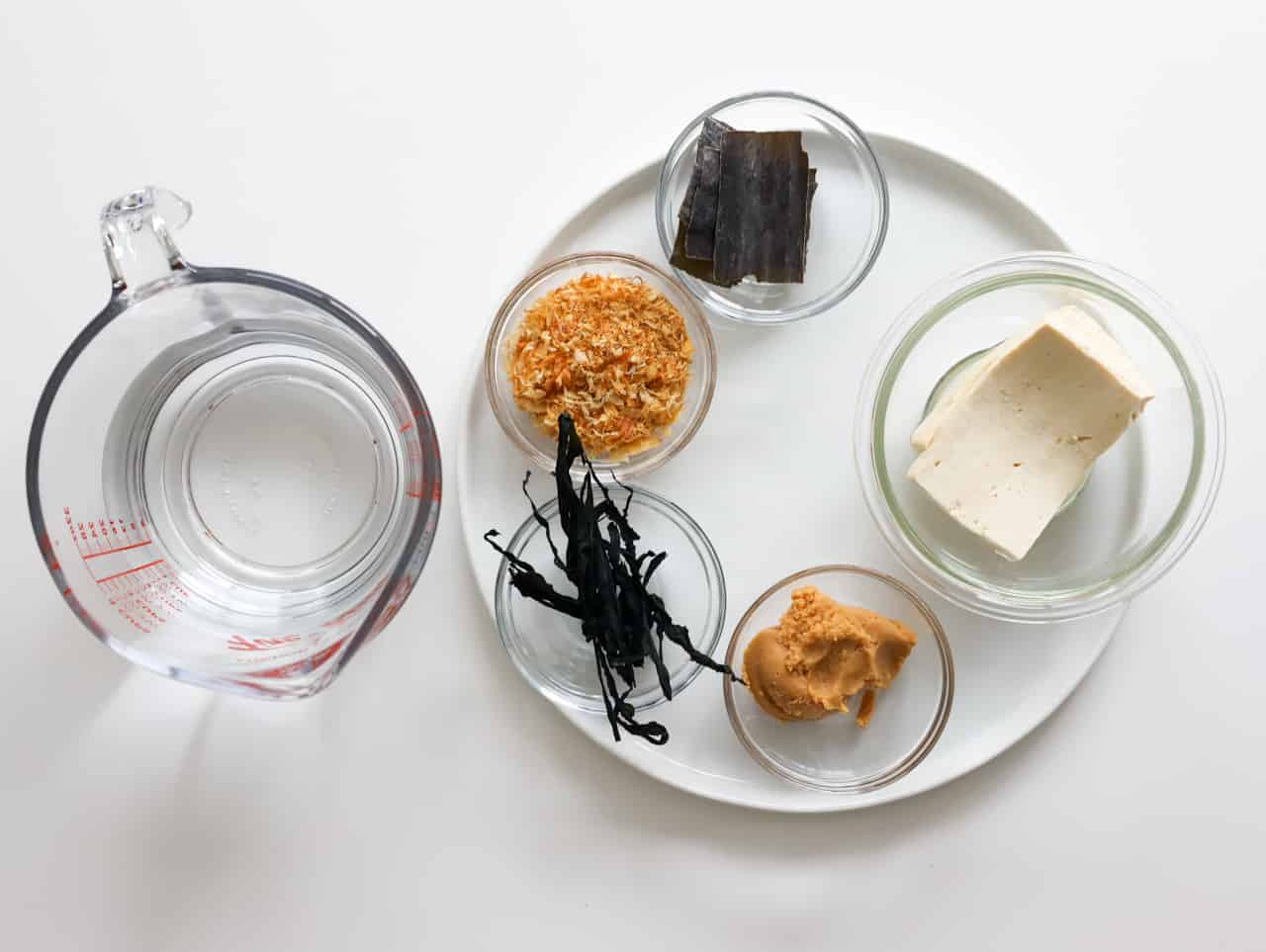
- Low-Sodium Yellow Miso (aka Shinshu Miso): A fermented soybean paste. The paste is a yellow brownish color that is thick and pasty. It's found in the refrigerated section of most Asian markets.
- Note: There are also different types of miso paste available, such as white miso paste and red miso paste and more. These are not the same as yellow miso. Each type of miso has a different taste and sodium level so be sure to get the yellow kind.
- Dried kelp (aka kombu): Do not wash the white salt content on the kelp. This salt offers flavor to the homemade dashi. You can find dried kelp in the dried section of most Asian grocers. Get the pre-cut kind that comes in rectangular shape, versus the larger sheets that you have to cut yourself to make it easier.
- Bonito Flakes (aka Smoked Skipjack Tuna): These are shavings of Skipjack Tuna for the homemade soup stock. They are pink-colored and come in two variations: finer shavings and larger shavings. Tip: buy the larger shavings instead the finer ones (as pictured below) so you can filter them out more easily.
- Dried Wakame Seaweed: A type of sea plant that is long and slender with a dark green color. This is the green stuff floating in the soup and it's not the same as dried kombo.
- Soft Tofu (aka Silken Tofu): This is usually found in the refrigerated section in most Asian and Western grocers. Or substitute with medium to firm tofu. I recommend buying the kind of soft tofu that comes in a block that you can easily remove from the packaging.
- Cold Water
- Green onions: optional garnish
Note: Most Asian grocery stores will carry these ingredients.
Expert Tips
- Buy larger bonito flakes for a cleaner tasting broth so they can be more easily filtered out by the fine sieve.
- Try to find soft tofu that doesn't fill the entire packaging so the block of tofu can easily be removed without breaking it apart. If you can't find this type of tofu and can only find the kind where the tofu is stuck to the edges of the package, follow the tip below to remove without breaking it.
- Gently small dice the soft tofu, about 1.5 cm pieces. This makes it more pleasant to eat versus large cubes.
- Remove the kelp as soon as the dashi stock boils to prevent a bitterness in the soup.
- Line the fine sieve with a clean paper towel to help strain the dashi stock of the bonito flakes. If you don't use a paper towel, some of the flakes will pass through especially if you buy the small kind.
- Use a whisk to break down the miso paste.
- To store leftover miso paste, place it in an airtight container in the fridge and if the miso came with paper on top of the paste, keep the paper in there. This absorbs excess moisture.
How to remove soft tofu from packaging?
If you can only find the soft tofu that fills the entire package from edge to edge making it hard to remove, follow these steps:
- Carefully glide a sharp knife along the edges of the plastic film to move it. Then turn over the package onto a clean cutting board so the tofu is facing down.
- Next snip off small pieces of the corners of the package - so some air can sneak between the tofu and the packaging.
- Then carefully and slowly lift up the package allowing gravity to pull the tofu down. This ensures your tofu doesn't break apart.
Instructions
Below are step-by-step instructions on how to make miso soup:
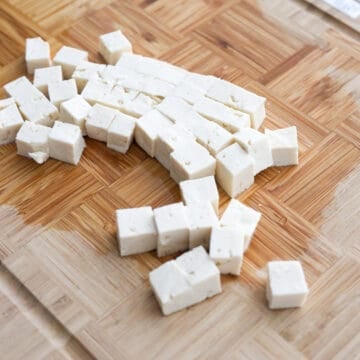
- First carefully remove soft tofu from packaging and strain excess liquids (see blog post under "Expert Tips" to smoothly remove the soft tofu if guidance is needed). Then slice tofu into small cubes with a sharp knife, about 1.5 cm x 1.5 cm each. Tip: Do not cut the tofu into large cubes as this doesn't taste as great in the miso soup.
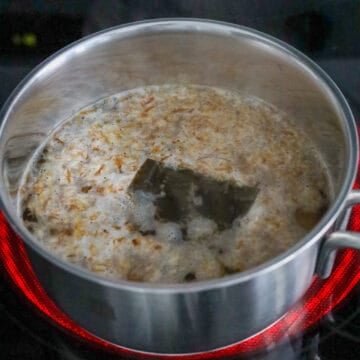
- Next in a small pot, add cold water, dried kelp and bonito flakes. Then cover and bring to boil on medium-high heat, uncovered.
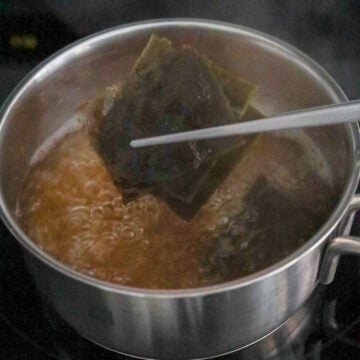
- As soon as it boils, only remove kelp to prevent the broth from becoming bitter in taste.
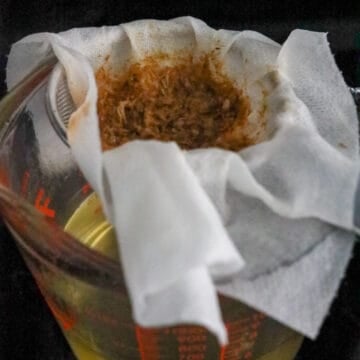
- Then over very low heat, cover and simmer the broth for 5 minutes. Meanwhile, place a clean paper towel into a fine sieve and rest it over a large measuring cup or bowl. Uncover and strain out the broth through the paper towel and fine sieve. Do not strain the broth without a paper towel or a fine sieve or it won't catch all the flakes. Pour this homemade dashi broth back into the pot.
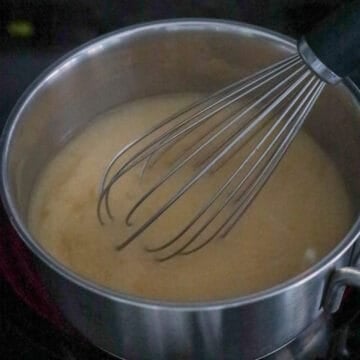
- On medium heat, mix miso paste into the dashi broth until combined with a whisk to break down the paste more quickly.
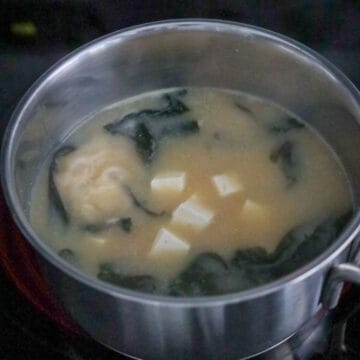
- Stir in dried wakame seaweed and allow it to expand. Then gently add diced tofu. Finally serve and garnish with green onions and enjoy!
Storage
- Leftover soup can be stored in an airtight container in the fridge. It will last up to 4-5 days. To reheat, add the soup to a small pot and bring it to a boil and serve hot.
- Freezer friendly? I don't recommend freezing leftover miso soup as the seaweed and tofu will become mushy.
Pairing Suggestions
Miso soup serves well with:
- starters like Japanese crab corn salad or salad with Japanese ginger salad dressing or Korokke
- seafood dishes like shrimp tempura, panko shrimp or ebi mayo
- protein dishes like ramen eggs, chicken katsu or tonkatsu, Karaage, Teriyaki Tofu, Teriyaki Chicken, or Ginger Miso Salmon.
- rice dishes like Oyakodon, Omurice, Shrimp Tempura Rice Ball, Onigiri, or Spicy Tuna Onigiri
- other noodle dishes like Yaki Udon, Creamy Mushroom Udon, or Udon Carbonara
- or Japanese egg salad sandwich
FAQ
This can be made in advance and stored in an airtight container in the fridge for up to 4-5 days. To enjoy, reheat it in the microwave or in a pot on the stovetop on medium heat.
Yes, but please follow package directions.
Miso soup is naturally gluten free.
Miso is a great ingredient used in Japanese cooking. You can use it to make salad dressings, in marinades or in sauces. Check out my Air Fryer Ginger Miso Salmon for a miso-based recipe!
Other recipes you may enjoy
📖 Recipe
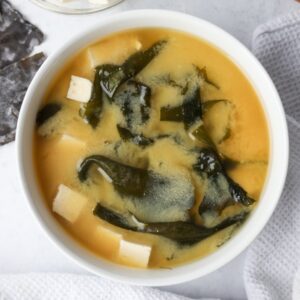
10-min. Easy & Simple Miso Soup
Ingredients
- 2 ¼ cups water cold
- 2.85 oz tofu soft or silken kind
- ⅓ cup bonito flakes (aka smoked skipjack tuna flakes)
- 2 tablespoon yellow miso paste reduced-sodium kind
- 4 pieces kombu (aka dried kelp)
- 0.10 oz wakame dried seaweed
- ½ green onion finely chopped as an optional garnish
Instructions
- Carefully remove soft tofu from packaging and strain excess liquids (see blog post under "Expert Tips" to smoothly remove the soft tofu if guidance is needed).
- Then slice tofu into small cubes with a sharp knife, about 1.5 cm x 1.5 cm each. Tip: Do not cut the tofu into large cubes as this doesn't taste as great in the miso soup.
- Next in a small pot, add cold water, dried kelp and bonito flakes. Then cover and bring to boil on medium-high heat, uncovered.
- As soon as it boils, only remove kelp to prevent the broth from becoming bitter in taste.
- Then over very low heat, cover and simmer the broth for 5 minutes. Meanwhile, place a clean paper towel into a fine sieve and rest it over a large measuring cup or bowl.
- Uncover and strain out the broth through the paper towel and fine sieve. Do not strain the broth without a paper towel or a fine sieve or it won't catch all the flakes. Pour this homemade dashi broth back into the pot.
- On medium heat, mix the miso paste into the dashi broth until combined with a whisk to break down the paste more quickly.
- Stir in dried wakame seaweed and allow it to expand. Then gently add diced tofu. Finally serve and garnish with green onions and enjoy!


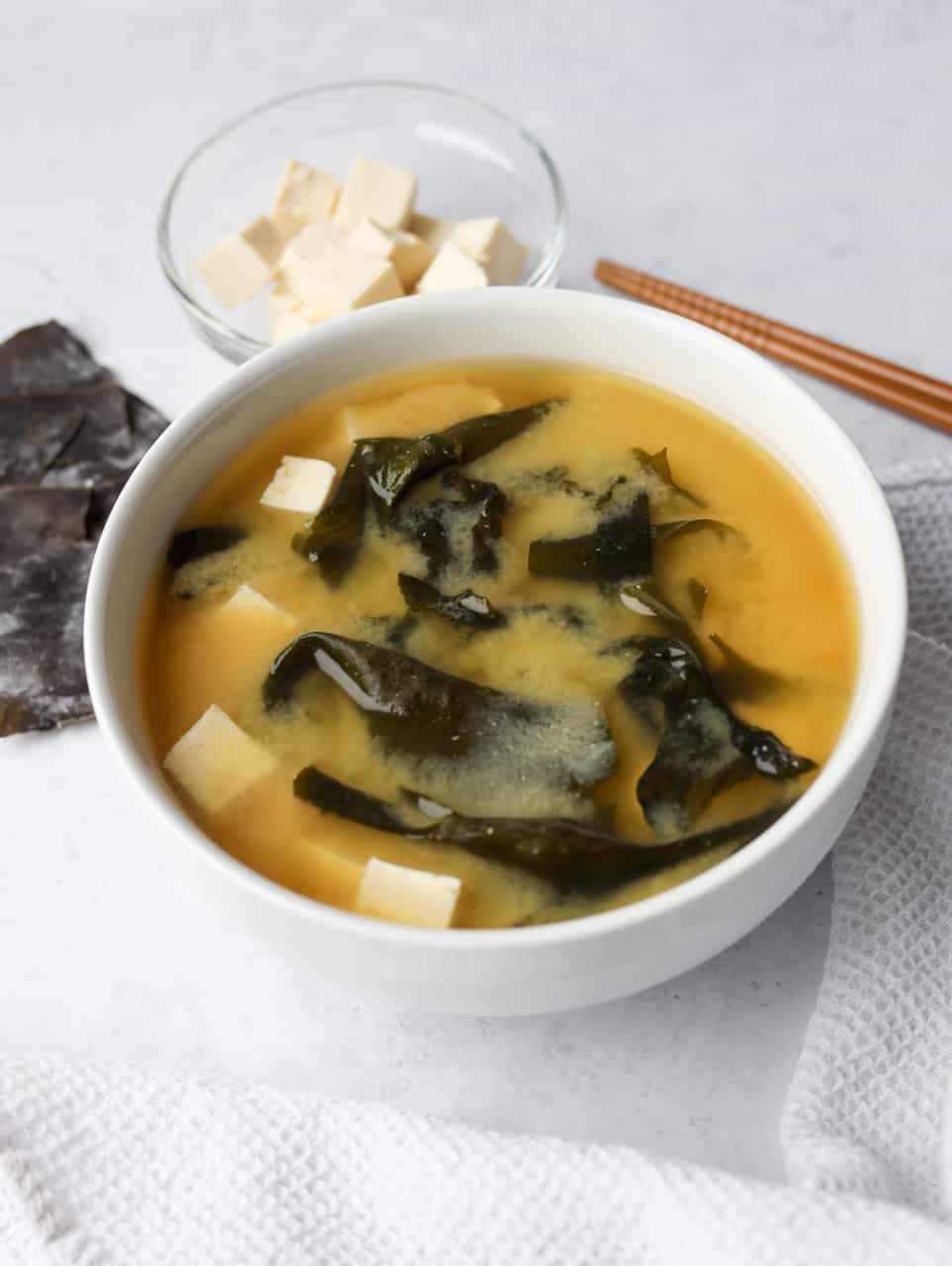
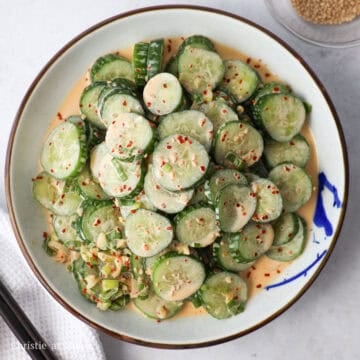



Rachelle
Can dried seaweed be used in place of wakame? Ho Dai ?
Christie Lai
I don't recommend that because if it's the flakey, thin kind, it'll get very soggy in the soup.
Kat
I made this two days ago and am currently making a double batch because it was so good and so easy to make!
christieathome
Thank you so much for making my recipe, Kat! Very pleased to hear that you enjoy it so much to make a double batch 🙂 Have a great night!
Toni
This recipe was perfect! The miso soup was delicious! Thank you!
christieathome
Thank you so much for your kind review, Toni! I'm so glad you enjoyed it! 🙂